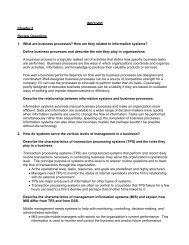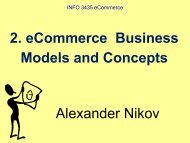Create successful ePaper yourself
Turn your PDF publications into a flip-book with our unique Google optimized e-Paper software.
COMP 6350 <strong>eCommerce</strong> systemsTeaching Objectives8. <strong>Social</strong> EcommerceAlexander Nikov• Explain the difference between a traditional social networkand an online social network.• Explain how a social network differs from a portal.• Describe the different types of social networks and onlinecommunities and their business models.• Describe the major types of auctions, their benefits andcosts, and how they operate.• Explain when to use auctions in a business.• Recognize the potential for auction abuse and fraud.• Describe the major types of Internet portals.• Explain the business models of portals.8-2<strong>Social</strong> Network Fever Spreads to theProfessionsClass Discussion• How has the growth of social networks enabled thecreation of more specific niche sites?• What are some examples of social network sites with afinancial or business focus?• Describe some common features and activities on thesesocial network sites.• What features of social networks best explain theirpopularity?Outline1. <strong>Social</strong> Networks and Online Communities2. Online Auctions3. <strong>eCommerce</strong> Portals8-3 8-4
<strong>Social</strong> Networks and Online CommunitiesWhat Is an Online <strong>Social</strong> Network?• Internet began as community building technology forscientists, researchers• Early communities limited to bulletin boards,newsgroups; e.g., the Well• Today: Mobile devices; sharing of photos, video; blogshave created new era of social networks• <strong>Social</strong> networks now one of most common Internetactivities• Area online where people who share common ties caninteract• Portals and social networks:– Moving closer together– Portals adding social networking features– Community sites adding portal-like services• Searching•News• E-commerce services8-58-6The Growth of <strong>Social</strong> Networks and OnlineCommunitiesTop 10 <strong>Social</strong> Network Sites, 2011• Top 10 social networks account for over 90%social networking activity• Facebook users: Over 50% are 35+• Unique audience size:– Top four U.S. social networks: 264 million– Top four portal/search engines: 650 million• Annual advertising revenue– U.S. social network sites: $3.08 billion– Top four portal/search engines: $19 billion8-7Figure 11.1, Page 712SOURCES: Based on data from eMarketer, 2011; Hitwise, 2011.8-8
Ad spending on social networks (in millions)Types of <strong>Social</strong> Networks and TheirBusiness Models• General communities:– Offer opportunities to interact with general audience organizedinto general topics– Advertising supported by selling ad space on pages and videos• Practice networks:– Offer focused discussion groups, help, and knowledge related toarea of shared practice– May be profit or non-profit; rely on advertising or user donations8-98-10Types of <strong>Social</strong> Networks And TheirBusiness Models (cont.)<strong>Social</strong> Network Features and Technologies• Interest-based social networks:– Offer focused discussion groups based on shared interest in somespecific subject– Usually advertising supported• Affinity communities:– Offer focused discussion and interaction with other people who sharesame affinity (self or group identification)– Advertising and revenues from sales of products• Sponsored communities:– Created by government, non-profit, or for-profit organizations forpurpose of pursuing organizational goals• Profiles• Friends network• Network discovery• Favorites• Games, widgets,apps• E-mail• Storage• Instant messaging• Message boards• Online polling•Chat• Discussion groups• Experts online• Membershipmanagement tools8-118-12
Outline1. <strong>Social</strong> Networks and Online Communities2. Online Auctions3. <strong>eCommerce</strong> Portals8-13 8-14Online Auctions• Online auction sites among the most popular consumer-toconsumersites on the Internet• eBay: market leader• Several hundred different auction sites in the United Statesalone• Established portals and online retail sites increasingly areadding auctions to their sites8-15Defining and Measuring the Growth ofAuctions and Dynamic Pricing• Dynamic pricing– Airline tickets, coupons, college scholarships– Prices based on demand characteristics of customerand supply situation of seller• Many types of dynamic pricing– Bundling– Trigger pricing– Utilization pricing– Personalization pricing8-16
Defining and Measuring the Growth ofAuctions and Dynamic Pricing• Auctions: One form of dynamic pricing– C2C auctions• Auction house an intermediary– B2C auctions• Business owns assets; often used for excessgoods– Can be used to• Sell goods and services• Allocate resources• Allocate and bundle resources8-17 8-18• Liquidity• Price discovery• Price transparency• Market efficiency• Lower transaction costs• Consumer aggregation• Network effectsBenefits of Auctions8-19Risks and Costs of Auctions forConsumers and Businesses• Delayed consumption costs• Monitoring costs– Possible solutions include:• Fixed pricing• Watch lists• Proxy bidding• Equipment costs• Trust risks– Possible solution—rating systems• Fulfillment costs8-20
Market-Maker Benefits• No inventory• No fulfillment activities– No warehouses, shipping, or logistical facilities• eBay makes money from every stage in auctioncycle– Transaction fees– Listing fees– Financial services fees– Advertising or placement feesInternet Auction Basics• Different from traditional auctions– Last much longer (usually a week)– Variable number of bidders who come and go fromauction arena• Market power and bias in dynamically priced markets– Neutral: number of buyers and sellers is few or equal– Seller bias: few sellers and many buyers– Buyer bias: many sellers and few buyers8-218-22Internet Auction Basics (cont.)Bias in Dynamically Priced Markets• Price allocation rules– Uniform pricing rule: multiple winners who all pay thesame price– Discriminatory pricing rule: winners pay different amountdepending on what they bid• Public vs. private information– Prices bid may be kept secret• Bid rigging– Open markets• Price matching8-23Figure 11.3, Page 7288-24
• English auctions:Types of Auctions– Single item up for sale to single seller– Highest bidder wins• Traditional Dutch auction:– Uses a clock that displays starting price– Clock ticks down price until buyer stops it• Dutch Internet auction:– Public ascending price, multiple units– Final price is lowest successful bid, which sets price forall higher bidders8-25Types of Auctions• Name your own price auctions– Users specify what they are willing to pay forgoods or services and multiple providers bidfor their business– Prices do not descend and are fixed• Consumer offer is commitment to buy atthat price– e.g., Priceline– Enables sellers to unload unsold excesscapacity8-26Types of Auctions• Professional service auctions– Example: Elance.com• Auction aggregators (mega auctions)– Use Web crawlers to search thousands of Web auctionsites and accumulate information on products, bids,auction duration, etc.– Unlicensed aggregators opposed by eBay8-27 8-28
8-29 8-30Table 11.7, Page 7428-31 8-32
Seller and Consumer Behaviorat AuctionsAuction Profits• Seller profit: arrival rate, auction length, and number ofunits at auction• Auction prices not necessarily the lowest• Unintended results of participating in auctions:– Winner’s regret– Seller’s lament– Loser’s lament• Consumer trust an important motivating factor inauctions8-33Figure 11.5, Page 737SOURCE: Vakrat and Seidmann, 1998.8-34When Auction Markets Fail: Fraud and Abusein Auctions• Markets fail to produce socially desirable outcomes infour situations:– Information asymmetry, monopoly power, publicgoods, and externalities.• Auction markets prone to fraud– Most common: failure to deliver, failure to pay• In 2010, 6% of Internet fraud complaints concern onlineauctions8-35 8-36
Outline1. <strong>Social</strong> Networks and Online Communities2. Online Auctions3. <strong>eCommerce</strong> Portals8-37 8-38<strong>eCommerce</strong> PortalsTop 5 Portal/Search Engines in theUnited States• Most frequently visited sites on Web• Original portals were search engines• As search sites, attracted huge audiences• Today provide:– Navigation of the Web– Commerce– Content (own and others’)• Compete on reach and unique visitors• Enterprise portals– Help employees find important organizational content8-39Figure 11.5, Page 742SOURCE: Based on data from comScore, 20118-40
Types of PortalsTwo General Types of Portals: GeneralPurpose and Vertical Market Portals• General purpose portals:– Attempt to attract very large general audience– Retain audience by providing in-depth vertical content channels– E.g., Yahoo, MSN• Vertical market portals:– Attempt to attract highly focused, loyal audiences with specificinterest in:• Community (affinity group); e.g., iVillage.com• Focused content; e.g., ESPN.com8-41Figure 11.6, Page 7468-42Portal Business Models• ISP services (AOL, MSN)– Provide Web access, e-mail for monthly fee• General advertising revenue– Charge for impressions delivered• Tenancy deals– Fixed charge for number of impressions, exclusivepartnerships, “sole providers”• Commissions on sales– Sales at site by independent providers• Subscription fees– Charging for premium content• Applications and games8-43Figure 11.7, Page 748Revenue per Customer and Market Focus8-44
QUESTIONS1. How does a social network differ from a portal? How are the two similar?2. What is an affinity community and what is its business model?3. What is personalization, or personal value pricing, and how can it be used atthe beginning of a product’s life cycle to increase revenues?4. List and briefly explain three of the benefits of auction markets.5. What are the two price allocation rules in auction markets? Explain thedifference.6. What types of products are well-suited for an auction market? At what points inthe product life cycle can auction markets prove beneficial for marketers?7. What are the two main types of vertical market portals and how are theydistinguished from one another?1. How does a social network differ from a portal? How are the twosimilar?• <strong>Social</strong> networks involve a group of people, shared social interaction, common tiesamong members, and people who share an area for some period of time. Portals aregeneral-purpose content providers that have a varied selection of features andcapabilities. <strong>Social</strong> networks are different from portals in that content creation is donealmost exclusively by the members of social networks, whereas portals both createand aggregate content from elsewhere. The two are similar in that their goal is tokeep visitors on their sites for a long time, or to mold themselves as a “sticky”destination site. Also, many portals have social networking features.8-458-462. What is an affinity community and what is its business model?• An affinity community is one in which members can participate in focuseddiscussions with others who share the same affinity, or group identification, such asreligion, ethnicity, gender, sexual orientation, or political beliefs. The business modelis a mixture of subscription revenue from premium content and services, advertising,tenancy/sponsorships, and distribution agreements.3. What is personalization, or personal value pricing, and how can it beused at the beginning of a product’s life cycle to increase revenues?• Personalization or personal value pricing is when merchants adjust prices based ontheir estimate of how much a customer truly values the product. For example, Webmerchants may charge committed fans of a musician a higher price for the privilegeof receiving a new CD before its official release to retail stores. It is a specific type ofdynamic pricing in which merchants match their prices to the personal value thatconsumers will receive from a purchase by estimating what they believe any givenconsumer is willing to pay. It can be used at the beginning of a product’s life cycle toincrease revenues because a certain consumer segment, the so-called earlyadopters,is willing to pay more for a newly released product.8-478-48
4. List and briefly explain three of the benefits of auction markets.• Liquidity: Sellers and buyers are connected in a global marketplace.• Price discovery: Even difficult to price items can be competitively priced based onsupply and demand.• Price transparency: Everyone in the world can see the asking and bidding prices foritems, although prices can vary from auction site to auction site.• Market efficiency: Consumers are offered access to a selection of goods that wouldbe impossible to access physically, and consumer welfare is often increased due toreduced prices.• Lower transaction costs: Merchants and consumers alike are benefited by thereduced costs of selling and purchasing goods compared to the physicalmarketplace.• Consumer aggregation: A large number of consumers who are motivated to buy areamassed in one marketplace—a great convenience to the seller.• Network effects: The larger an auction site becomes, in both the numbers of usersand products, the greater all of the above benefits become and therefore the morevaluable a marketplace it becomes.• Market maker benefits: Auction sites have no inventory carrying costs or shippingcosts, making them perhaps the ideal online business in that their main function isthe transfer of information.8-495. What are the two price allocation rules in auction markets? Explain thedifference.• The two price allocation rules in auction markets are uniform pricing anddiscriminatory pricing. When a uniform pricing rule is in effect, there are multiplewinners who all pay the same price, usually the lowest winning bid. The lowestaccepted offer sets the price. When a discriminatory pricing rule is in effect, winnerspay different amounts depending on the amount they bid. Each customer pays itswinning bid.8-506. What types of products are well-suited for an auction market? At what pointsin the product life cycle can auction markets prove beneficial for marketers?• The types of products that are well-suited for an auction market include rare andunique products where prices are difficult to discover and where there may havebeen no market for the goods. These include perishable items such as airline tickets,hotel rooms, car rentals, or tickets to plays, concerts, and sporting events.Traditionally, auctions have been used by businesses to generate a higher profit onitems at the end of their life cycle than they would receive from product liquidationsales. However, they are now more frequently being used at the beginning of aproduct’s life cycle to generate premium prices from highly motivated early adopters,for example: early releases of music, books, DVDs, video games, and digitalappliances.7. What are the two main types of vertical market portals and how arethey distinguished from one another?• The two main types of vertical market portals are affinity group portals and focusedcontent portals. Affinity group portals seek to attract statistical aggregates of peoplewho identify themselves by their attitudes, values, beliefs, and behavior. They exist toserve such broad constituencies as women, African Americans, and gays as well asmuch more focused constituencies like union members, religious groups, and evenhome schooling families. Focused content portals contain in-depth information on aparticular topic that all members are interested in. They can provide content on suchbroad topics as sports, news, weather, entertainment, finance, and business, or theycan appeal to a much more focused interest group such as boat, horse, or videogame enthusiasts.8-518-52
















